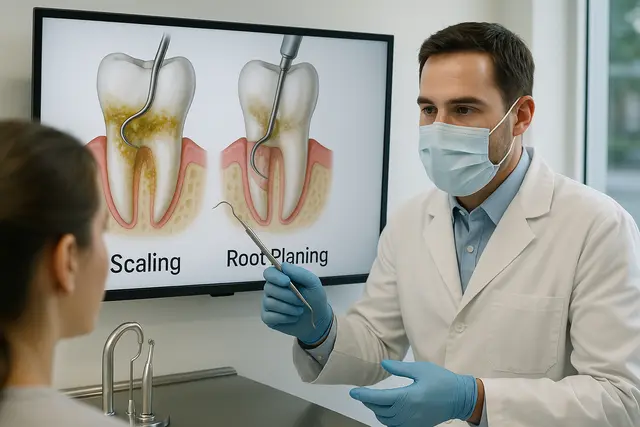General Dentistry
5 min read
Aug 12, 2025
What Is a Surface Cavity and How Does It Affect Your Teeth?
Cavities are one of the most common dental problems, but not all are the same. A surface cavity may seem harmless at first glance, yet it can quietly damage your enamel and lead to more serious issues if untreated. Understanding what it is and how it affects your teeth can help you protect your oral health.

Cavities Are More Common Than You Think
Cavities are one of the most common dental problems in the world. Yep, you read that right. They affect people of all ages, basically anyone with teeth. But not all cavities show up in the same way. Some develop slowly and quietly on smooth tooth surfaces, while others set up camp on the chewing surfaces of your molars.
One sneaky intruder? The surface cavity. These little troublemakers may seem innocent, but left untreated, they can spiral into serious dental drama.
What Is a Surface Cavity Exactly?
A surface cavity is a specific type of cavity that forms on the outermost area of the tooth enamel, usually on the smooth surface. That’s the flatter area on the sides or back of your tooth, where brushing alone might not always cut it. Unlike pit and fissure cavities that like to set up camp in the grooves of your molars, surface cavities are usually more visible but easier to miss if you're not paying attention.
Think of it like rust on a car. It starts on the surface and, if ignored, eats its way deeper. A cavity is a hole caused by tooth decay, and when that cavity occurs on the smooth surface of your tooth, it’s called, you guessed it, a surface cavity.
The Stages of Tooth Decay You’ll Want to Avoid
Here’s where things get serious. Tooth decay doesn't happen overnight. It's a slow burn that goes through stages of tooth damage. In the beginning, you might just have a small cavity. No big deal, right? But once the decay has spread past the enamel and reaches the inner layers, like the dentin or even the pulp inside your tooth, that’s when things start to hurt, literally.
The final stage? When decay has reached the tooth root. That’s when your dentist might mention words like root canal therapy or even tooth extraction. Not ideal.
So yes, early treatment is your best friend. Catch it early, and cavity treatment is pretty simple. Wait too long, and you're heading into root canal territory.
The Different Types of Cavities Explained
Let’s break down the major types of cavities so you can tell them apart:
Smooth surface cavities: These pop up on the flat, visible parts of your teeth. They’re slow-growing and more preventable with good dental hygiene and fluoride treatments.
Pit and fissure cavities: Found in the deep grooves of molars, where food loves to hide. Large pit and fissure cavities can cause major tooth damage if left alone.
Root cavities: These occur on the surface of a tooth’s roots, often in older adults or folks with gum recession. It’s especially important to treat root cavities early before they reach the tooth root.
Each type of dental cavity has its own quirks, but all are caused by tooth decay at their core.
What Causes Cavities on the Surface of Your Teeth?
The causes of cavities are pretty straightforward. You’ve got sugar-loving bacteria living in your mouth. When you eat carbs (we’re looking at you, bread, chips, and candy), those bacteria throw a sugar party and produce acids. These acids wear down your tooth enamel, creating areas of tooth decay.
Surface cavities occur when this acid attack happens on the outer sides of your teeth. If you skip regular dental checkups or aren’t flossing like you promised your hygienist you would, those bacteria get comfy and start digging in.
Why Surface Cavities Can Be Sneaky but Serious
Because surface cavities usually occur on the smooth areas of your teeth, they can fly under the radar. There’s often no pain at first, which makes it easy to shrug off. But just because you don’t feel it doesn’t mean the decay isn’t progressing.
Eventually, the cavity becomes deeper. If the decay has reached the dentin or pulp inside your tooth, you’re at risk of infection, tooth loss, or needing a root canal therapy. Yikes.
This is why cavities are one of the most common dental issues that start off small but become big, expensive problems if you ignore them.
How a Dentist Detects Surface Cavities
You can’t fix what you don’t see. That’s where your dentist comes in. During regular dental visits, your dental professional will check every tooth surface for signs of decay. They may use a mirror, probe, and sometimes X-rays to spot interproximal cavities hiding between your teeth.
Even a small cavity can turn into a medium cavity (and then a large one) if you don’t catch it in time. And unless the cavity is shallow and caught early, your dentist will need to remove the decayed part and fill the cavity with dental fillings.
Cavity Treatment and Other Options
Now for the good news: cavity treatment doesn’t have to be scary. If it’s a small cavity and hasn’t reached the inner part of the tooth, a quick filling usually solves the problem.
Here are some common treatment options, depending on how far the decay has spread:
Fluoride treatments for early-stage decay on the smooth surface.
Dental fillings for moderate surface cavities.
Root canal therapy if the decay has reached the pulp inside your tooth.
Dental crown to protect a weakened or heavily filled tooth.
Tooth extraction as a last resort when the damage is too severe.
How to Prevent Cavities Before They Form
Want to prevent cavities? It’s not rocket science. Here are a few ways to lower your risk of tooth decay:
Brush twice a day and floss daily (yes, really).
Use a fluoride toothpaste and ask your dentist about fluoride treatments.
Don’t skip your regular dental checkups.
Watch your sugar intake.
Stay hydrated to keep dental plaque in check.
Clean around the tooth properly, flossing especially helps with interproximal cavities.
Remember, cavities usually start small. But cavities can form quickly if you don’t stay on top of your dental hygiene game.
When to Worry About a Cavity and What to Watch For
Here’s how to tell it might be time for a cavity to get checked:
Sensitivity to hot, cold, or sweet foods
Visible holes or dark spots on your tooth surface
Bad breath that won’t quit
Swelling in the tissue around the tooth
If you notice any of these, schedule an appointment. Early treatment always beats waiting for decay to worsen.
Trustworthy Dental Advice From a Friendly Source
You don’t have to be a dentist to understand what’s happening inside your mouth. But having a reliable dental blog (like this one) that breaks it down without all the jargon? That’s a win. Whether you're brushing up on the causes of cavities or trying to understand the stages of tooth decay, a little knowledge goes a long way.
At the end of the day, cavities are one of those common dental issues that sneak up on you, but they don’t have to win. Stay consistent, listen to your dentist, and don't let a surface cavity become a full-blown dental crisis.
What Is a Surface Cavity and Why Should It Be Treated Early?
A surface cavity is a type of tooth decay that occurs on the smooth, flat areas of a tooth’s outer enamel. While it often develops more slowly than other cavities, ignoring it can allow decay to penetrate deeper into the tooth, reaching the dentin or pulp. Early treatment prevents the need for more invasive procedures like root canals or crowns and helps preserve tooth strength and appearance.
How Do Surface Cavities Develop?
Surface cavities form when plaque bacteria feed on sugars and produce acids that erode tooth enamel. Poor brushing and flossing habits allow plaque to accumulate, especially between teeth and along the gumline. Over time, these acids create small holes in the enamel, which can progress if not addressed. Smooth-surface cavities are more likely to respond to fluoride treatments when detected in their early stages.
How Are Surface Cavities Different From Other Types of Cavities?
Unlike pit and fissure cavities, which form in the deep grooves of molars, or root cavities, which develop on exposed tooth roots, surface cavities occur on the flat, outer surfaces of teeth. They generally progress more slowly but can still lead to significant damage if untreated. Because they’re on visible surfaces, dentists can often spot them during routine checkups and treat them before they cause major problems.
What Are the Best Ways to Prevent Surface Cavities?
Prevention involves consistent oral hygiene, including brushing at least twice daily with fluoride toothpaste and flossing to remove plaque between teeth. Limiting sugary snacks and drinks reduces the fuel for cavity-causing bacteria. Regular dental checkups ensure early detection, and professional fluoride treatments or dental sealants can add extra protection to tooth enamel.
Read Next
Related Posts

General Dentistry
How to Stop Nerve Pain in Tooth: Fast Relief That Works
Tooth nerve pain can be one of the most intense and disruptive types of discomfort. It often strikes without warning and makes everyday activities like eating, drinking, or even talking feel unbearable. Understanding what causes this pain and how to manage it effectively is key to getting fast relief.
4 min read
Sep 15, 2025

General Dentistry
Can a Sinus Infection Make Your Jaw Hurt? Understanding the Connection
Jaw pain can be unsettling, especially when it seems to appear out of nowhere alongside a stuffy nose or headache. Many people are surprised to learn that sinus infections can cause discomfort that feels like it’s coming from the jaw. Understanding the connection between your sinuses and jaw pain is key to getting the right treatment.
5 min read
Sep 15, 2025

General Dentistry
What Is SRP in Dentistry? A Complete Guide to Scaling and Root Planing
When it comes to dental health, most people think regular cleanings are enough to keep their smile safe. But sometimes, what’s happening below the gumline needs more attention. Scaling and root planing (SRP) is a treatment designed to address gum disease at its source, protecting both your gums and teeth from long-term damage.
5 min read
Sep 10, 2025
Don’t have time to research every dentist around you?
See why 30k+ patients trusted us